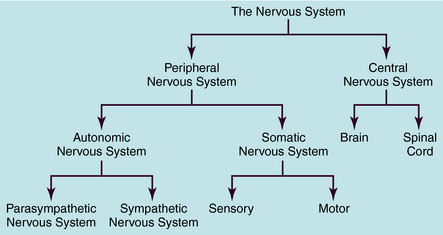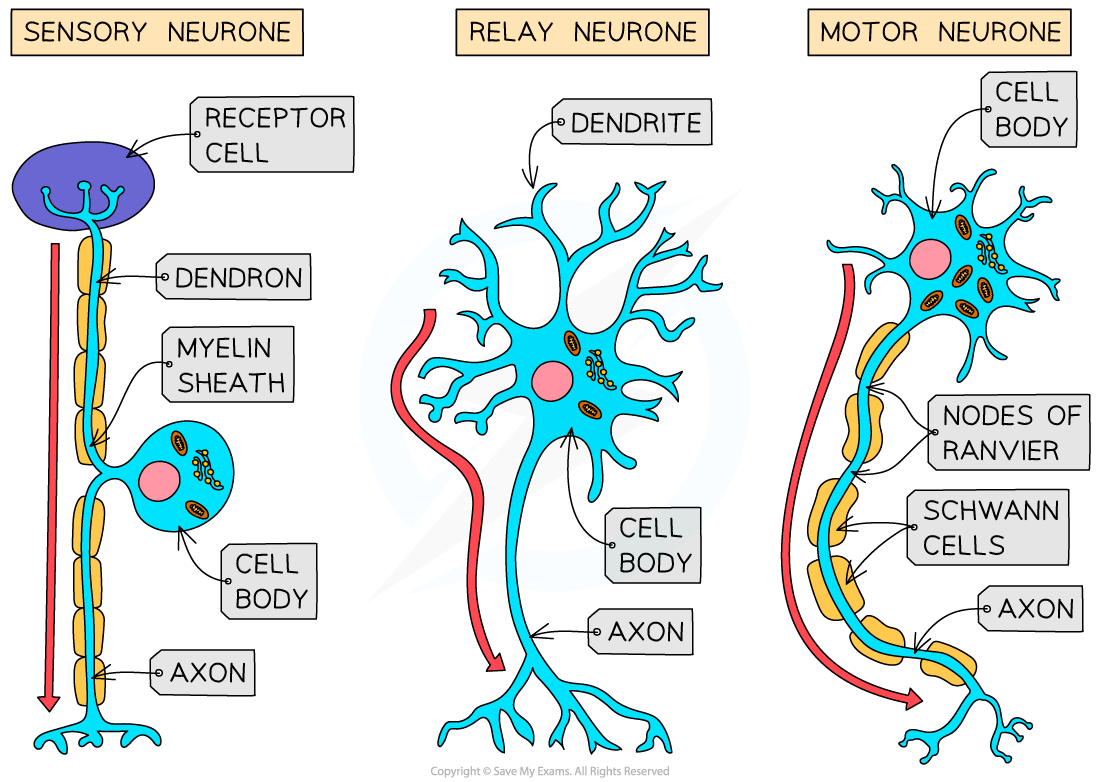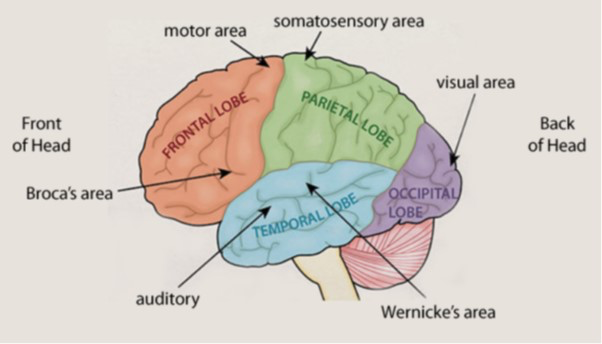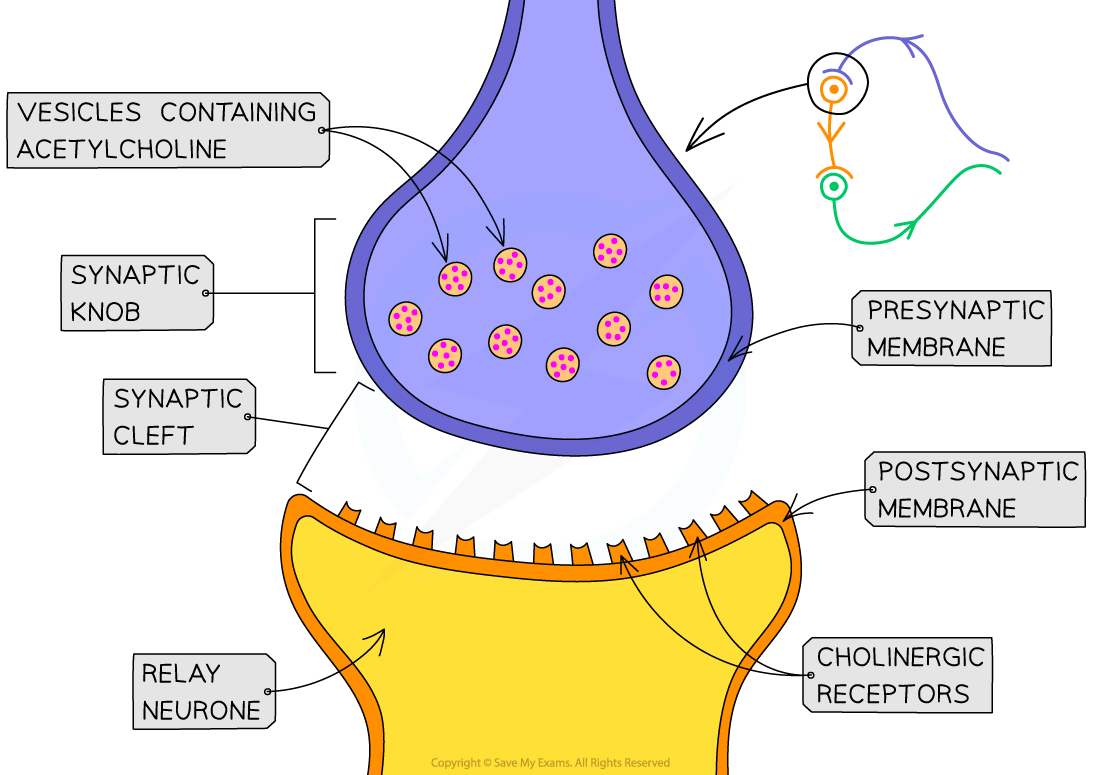Biopsychology
The study of the biology of behaviour, it focuses on the nervous system hormones and genetics.
Nervous System
A network of cells in the human body that is our primary internal communication sytem
it communicates using electrical and chemical signals
collects and processes and responds to information in the environment
to coordinate the different working of organs/cells
divided in PNS and CNS

CNS
Brain
- controls higher mental functions
- outer layer (cerebral cortex) is 3mm thick
- divided into 2 hemispheres
Spinal Chord
- passes messages too and from the brain
- connects nerves to the PNS
PNS
- transmits messages from neurones too and from the CNS
- ANS- governs life maintaining processes
- SNS- transmits info from sensory receptors to the CNS and info from the brain to muscles to produce movements
ENDOCHRINE SYSTEM
- various glands produce hormones
- instructs glands to release hormones directly into the blood stream
- slower than the nervous system
- hormones are biomedical substances that circulate in the blood but only effect target organs
Endochrine + ANS = fight or flight
- when a stressor is perceived the pituitary gland triggers the sympathetic nervous system
- adrenaline is released from the adrenal gland which triggers physiological changes in the body to prepare for fight or flight
- once the threat has passed the parasympathetic nervous system is triggered and returns its body to its normal resting state
NEURONES AND SYNAPTIC TRANSMISSION
there are 3 types of neurones- sensory, motor and relay
location of neurones
- the cell body of the motor neurone is in the CNS but due to the length of the axons, they form part of the PNS
- sensory neurones are in the PNS in clusters called ganglia
- relay neurones are found in the brain and visual system
electrical vs chemical
- in its resting state the inside of a neurone is negatively charges
- when faced with a stimulus the neurones is actively charged causing action potential, which pushes and electrical charge down the axon, to the end of the neurone
- signals between neurones are transmitted chemically across the synapse
- when he electrical impulse reaches the end of the neurone the presynaptic terminal triggers the relapse of neurotransmitters
neurotransmission
- the electrical signal is converted into a chemical signal
- vesicles of neurotransmitters bind to the presynaptic membrane of the axon terminal
- the neurotransmitter is then released and diffuses across the synapse binding to the receptor site on the dendrite of the next neurone.
- the dendrite then converts the chemical signal into an electrical signal
excitation and inhibition
excitation- when a neurotransmitter releases a positive charge of the postsynaptic neurone. this increases the likelihood the neurone will fire
inhibition- when the neurotransmitter decreases the positive charge making git less likely to fire
summation- whether or not the postsynaptic neurone fires the message due to the total charge of the signal

sensory neurones have long dendrites and short axons
motor neurones have short dendrites and long axons
relay neurones have short dendrites and short axons
LOCALISATION OF THE BRAIN
localisations vs holistic theory
- before the 19th century scientists supported the holistic theory that all parts of the brain were involved in the processing of everything
- however Broca and Wernicke argued localisation that different parts of the brain has different functions
Hemispheres
the brain consists 2 hemispheres, the left and the right
the two hemispheres are contralateral for motor functions meaning the left controls the right and the right controls the left
the left hemisphere contains the language centre
outer layer= cerebral cortex
cortex of each hemisphere has 4 lobes- frontal (logical thinking, decision making and speech motor control), temporal (auditory processing and memory), occipital (visual information) and parietal (senses)

Brocas area- language centre → speech production
auditory area- process speech based information
Wernickes ares- language centre → language understanding
visual area- each eye sends visual information from right visual field to the left visual cortex and vice verca
somatosensory- sensory information from the skin
Brocas area
- damage to Brocas area results in brocas aphasia- slow and laborious speaking
- his most famous patient was Tan as that was all he could say
Wernickes area
damage to this area results in Wernickes aphasia- words could be produced bu what was said didn’t make any sense
Phineas Gage
- pipe entered through the frontal lobe
- Gages personality changes and he became hostile, aggressive and impatient supporting the idea of localisation
Dougherty et al (2002)
- in extreme cases of OCD cingulotomies are conducted severing the cingulate gyrus (associated with feelings of disgust and unpleasant emotions
- Dougherty asked 44 patients who had undergone cingulotomies whether it had impacted their symptoms
- after 32 weeks post surgery, 30% reported successful and 14% partial improvement. suggests cingulate gyrus is responsible for emotional characteristics of OCD
- supports localisation
✅- case study support from Phineas Gage
✅- research evidence from Dougherty
✅- support from brain scans- Peterson demonstrated that Wernickes area was active during a listening task and Brocas area was active during a reading task
❌- lacks population validity and generalisation
❌- challenge from animal studies- Lashleys research was conducted on rats within a learning maze, where 10-15% of brain regions were severed to understand whether learning is localised, he found that no area of the brain was more important in the ability of learning how to navigate the maze.
PLATICITY
- the brains tendency to change and adapt throughout life, as a result of experience and new learning
- during infancy, the brain experiences growth in synaptic corrections, peaking at 2-3 years where there are twice as many as in the adult brain
- as we age rarely used connections are deleted and frequently used connections are strengthened- this is called synaptic pruning
- synaptic pruning enables lifelong plasticity where new neural connections are formed in response to new demands on the brain
Research
Maguire et al (2000)
- studied the brain of London taxi drivers and found significantly more volume of grey matter inn the posterior hippocampus than in a matched control group
- London cabbies have to take a test which asses their recall. Maguire found that his learning experiences alters the structure of taxi driver brains
- they also found the longer the taxi driver had been in the job the more pronounced the structural difference (positive correlation)
Dranganski et al (2006)
- imaged the brains of medical students 3 months before and after their final exams
- learning-induced changes were seen to have occurred in the posterior hippocampus and parietal cortex, presumably as a result of learning
Bezzola et al (2012)
- found that 40 hours of golf training produced changes in the neural representation of the movement in participants aged 40-60 years
- using fMRI the researchers observed a change in motor cortex activity in the novice golfers compared to a control group, suggesting more efficient neural representations after training
Holzel et al (2011)
- mindfulness may alter the structure and function of the brain
- Individuals who took part in an 8 week mindfulness-based stress reduction course showed an increase in grey matter in the left hippocampus
✅- research support
❌- the brains ability to rewire itself can have negative behavioural consequences. Mechina et al found prolonged drug use can result in poorer cognitive functioning and increased risk of dementia
❌- 60-80% of amputees develop phantom limb syndrome= a result of cortical reorganisation in the somatosensory cortex that occurs because of limb loss
functional recovery of the brain after trauma
a form of plasticity, following damage through trauma, the brain has the ability to redistribute or transfer functions from a damaged area to an undamaged area
this can occur quickly after trauma and then slow down after several weeks or months then the individual may require rehabilitate therapy to further recover
- the brain can rewire and recognise itself by forming new synaptic connections close to the area of damage
- secondary neural pathways that wouldn’t usually be used to carry out certain functions are activated to enable functioning to continue, often in the same way as before.
this process is supported by a number is structural changes in the brain including:
- axonal sprouting- growth of new nerve endings which connect with other undamaged nerve cells to form new neural pathways
- denervation supersensitivity- when axonsdoa similar jobbecome aroused to a higher level to compensate for the ones that are lost
recruitment of homologous areas- on the opposite side of the brain so specific tasks can still be performed
WAYS OF STUDYING THE BRAIN
techniques for investigating the brain are often used for medical purposes in the diagnosis of illness- ecological validity
fMRI- functional magnetic response imaging
- a method used to measure brain activity when a person is completing a task
- detects the changes in blood oxygenation and flow
- haemodynamic response- when the blood flow is directed to active parts of the brain
- it produces 3D images (activation maps) showing the active parts of the brain
✅- doesn’t use radiation so safer and easier (unlike PET scan)
✅- images have high spatial resolution
❌- poor temporal resolution- images aren’t viewed as activity is occurring (5s lag)
❌- expensive
EEG- electroencephalogram
- measures electrical activity using electrodes fixed to the scalp using a skull cap
- the scan recording represents the brainwave patterns that are generated from the action of thousands of neurones, producing a general account of brain activity
- EEGs are often used as a diagnosis technique. unusual arithmic patterns can indicate neurological abnormalities e.g. epilepsy, tumours
✅- research support- Hubel and Wiesel: sewed one eye of a kitten shut and found that the area if the visual cortex associated with the shut eye wasn’t , but continued to process information from the open eye
❌- level of education may influence recover rates
HEMISPHERIC LATERALISATION
lateralisation is the idea that the 2 halves of the brain are functionally different and that each hemisphere has functional specialisation
Split brain research- Sperry
- if 2 words were presented in each visual field (key on left, ring on right) they would say ring and and pick up the key
- if patients were shown an object in their LVF they can pickup the object but not verbalise what they are selecting
- when a picture of an object was shown to the RVF they could easily describe what was seen, but when shown to the LVF they could only draw the image
- a picture is shown to the LVF or RVF and patient is asked ti draw it the drawings were consistently better when drawn by the left hand
- when asked to match faces, when presented to the LVF where consistently selected whilst those presented to the RVF were ignored
✅- Sperrys method was highly controlled: patients were given eye patched
✅- research support: Luck et al showed that split brain participants perform better than connected controls on certain tasks
❌- causal relationships difficult to establish: no control group
CIRCADIAN RHYTHMS
biological rhythms- distinct patterns of changes in body activity that conform to artificial time periods
influenced by internal body clock and external environment
- the fact we feel drousy at night and alert during the day demonstrates the effect of daylight (exogenous zeitgeber) on our sleep/wake cycle
- it is also governed by an internal (endogenous) pacemaker- suprachiasmatic nucleus (SCN): lies just above optic chasm in hippocampus
Michel Siffre
- spent several extended period underground to study the effects on his own biological rhythms
- deprived of natural light and sound
Aschoff and Weaver
pps spent 4 weeks in WW2 bunker
all but 1 displayed circadian rhythm btweeen 24-25 hours
suggests natural sleep cycle longer than 24 hours
core body temp varies approx 2 degrees: 36 at 4am, 38 at 6pm
may suggest body body temp may have an effect on mental abilities
✅- provides understanding of the adverse consequences that occur when they’re disrupted, night workers engaged in shift work experience reduced concentration around 6am
✅- used him to improve medical treatments
❌- generalisations are difficult to make
EXOGENOUS ZEITGEBERS
- external factors in the environment that affect or control our biological rhythms, such as the influence of light on the sleep/wake cycle
- the free running sleep/wake cycle is brought into line by environmental cues so there’s an interaction on internal and external factors
light
- light is a key zeitgeber in humans- it can reset the bodies main endogenous pacemaker
Campbell and Murphy (1998)
demonstrated that light may be detected by skin receptor sites on the body even when the same information was not received by the eyes: 15 pps were woken at various tunes and a light pad was shone on the back of their knees. this produced a deviation in pps usual sleep/wake cycle of up to 3 hours in some cases
Wong et al (2022)
circadian rhythms are regulated by internal body clocks. found that zeitgebers in modern society more difficult to entertian babies. hormones carried by mothers milk can affect babies, e.g. coffee
social cues
- babies are not on the same sleep/wake cycle as the rest of the family
- at 6 weeks the circadian rhythm begins and by 16 weeks babies rhythms have been entrained by the schedules imposed by the parents
- research of jet lag suggests adapting to local times for eating and sleeping is an effective way of entraining circadian rhythms as quickly as possible
❌- exogenous Zeitgebers don’t have the same effect in all environments- people who live in the Artic circle have a similar sleep pattern all year round despite spending around 6 months in almost total darkness
❌- Miles et al recount the study of a young man who was blind from birth. had an abnormal circadian rhythm of 24.9 hours. despite exposure to social cues his sleep/wake cycle couldn’t be adjusted
